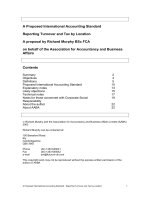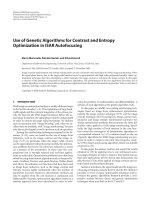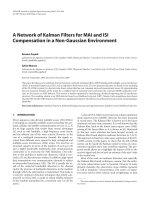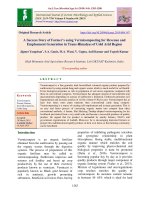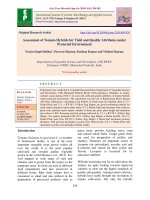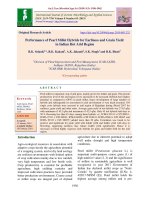Studies on substitution of inorganic fertilizers for organic and biological fertilizers in Ashwagandha (Withania somnifera Dunal.) production
Bạn đang xem bản rút gọn của tài liệu. Xem và tải ngay bản đầy đủ của tài liệu tại đây (190.06 KB, 7 trang )
Int.J.Curr.Microbiol.App.Sci (2019) 8(4): 1893-1899
International Journal of Current Microbiology and Applied Sciences
ISSN: 2319-7706 Volume 8 Number 04 (2019)
Journal homepage:
Original Research Article
/>
Studies on Substitution of Inorganic Fertilizers for Organic and Biological
Fertilizers in Ashwagandha (Withania somnifera Dunal.) Production
R. Praveen1*, N. Hari Prasad Rao2 and G. Sathyanarayana Reddy3
1
College of Horticulture, Venkataramannagudem, Dr Y.S.R Horticultural University,
Andhra Pradesh, India
2
College of Horticulture, Rajendranagar, Dr Y.S.R Horticultural University,
Andhra Pradesh, India
3
Herbal garden, Rajendranagar, Dr Y.S.R Horticultural University, Andhra Pradesh, India
*Corresponding author
ABSTRACT
Keywords
Yield, Quality,
Economics,
Alkaloids, Green
manure
Article Info
Accepted:
15 March 2019
Available Online:
10 April 2019
A field experiment was conducted at College of Horticulture, Venkataramannagudem,
West Godavari district, Andhra Pradesh during late kharif season of 2010 with an
objective to evaluate the package of organic and biological sources of nutrients vis-à-vis
inorganic fertilizers on yield, quality and economics of ashwagandha. The experiment was
laid out in randomized block design with fourteen treatments replicated thrice. The
treatments consisted of nutrients from different organic sources Viz., Neem cake,
vermicompost, poultry manure, farm yard manure, sunnhemp in situ green manure,
biological sources viz., Azospirillum + PSB alone and in combination with organic sources
of nutrients and inorganic sources viz., recommended dose of fertilizers (N P K at 40:60:20
kg ha-1) and 50 % recommended dose of fertilizers (N P K at 20:30:10 kg ha -1). The study
revealed that application of Poultry manure + Biofertilizers (Azospirillum + PSB)
produced longest roots (21.00 cm) with widest diameter (1.59 cm) but was on par with
vermicompost + biofertilizers and recommended dose of inorganic fertilizers. The same
treatment i.e., Poultry manure + Biofertilizers recorded maximum fresh root (1524 kg
ha-1), dry root (739 Kg ha-1) and seed yield (186.4 kg ha-1) but was on par with
vermicompost + biofertilizers and recommended dose of inorganic fertilizers. Similar trend
was observed in respect of total alkaloid content of roots. The treatment poultry manure +
Biofertilizers also recorded maximum gross (Rs 96,202) and net income (Rs 72,252) but
B:C ratio was maximum in recommended dose of fertilizers (3.12) followed by Poultry
manure + Biofertilizers. Thus, Poultry manure + Biofertilizers with overall better
performance and economic advantage over other treatments can be recommended for
complete substitution of inorganic fertilizers in ashwagandha.
Introduction
Ashwagandha (Withania somnifera Dunal.)
popularly known as “Indian ginseng” is an
important cultivated medicinal plant of India.
The root of the plant is mainly used in
ayurvedic and unani preparations. The
pharmacological activity of roots is attributed
1893
Int.J.Curr.Microbiol.App.Sci (2019) 8(4): 1893-1899
to the presence of alkaloids with anine and
somniferine. It is used as an antistress,
immunomodulatory, anticancer, antioxidant,
anti arthritic, antidepressant, diuretic,
hypocholestraemic and adaptogenic. In the
last 40-50 years farmers are heavily
dependence on inorganic fertilizers to
maximize crop yields resulted in negative
change in soil physical and chemical
properties. In the changing scenario, the
technology based primarily on continuous use
of chemical inputs with only a meagre
supplementation of organic manures is
thought to be not sustainable since the
productivity of soils is fast deteriorating. In
international trade, the herbal medicines and
products produced through organic forms
command premium price and in much
demand. Therefore, farmers are searching for
alternatives to replace the chemical fertilizers
by production and use of organic manures and
biofertilizers. Since, very limited systematic
research efforts have been made to optimize
the organic sources of nutrients to enhance the
productivity and quality, the present
experiment was carried out to study the
productivity, quality and economics of
ashwagandha as influenced by organic and
bionutrition.
Materials and Methods
A field experiment was conducted during late
Kharif season of 2010 at College of
Horticulture, Venkataramannagudem, West
Godavari Dist (Andhra Pradesh) under
irrigated conditions. The soil of the
experimental site was sandy loam in texture,
neutral in reaction, low in organic carbon, low
in available nitrogen (192 kg/ha), high in
available phosphorus (28.5 kg/ha) and
medium in available potassium (255 kg/ha) .
The studies were carried out using
ashwagandha cv. Poshita with 14 treatments
viz., neem cake 4 t ha-1 (NC 4 t ha-1: T1),
vermicompost 5 t ha-1(VC 5 t ha-1: T2),
poultry manure 5 t ha-1 (PM 5 t ha-1: T3), farm
yard manure 12 t ha-1 (FYM 12 t ha-1: T4),
insitu green manuring with sunnhemp (GM:
T5), NC 4 t ha-1 + BF (T6), VC 5 t ha-1 + BF
(T7), PM 5 t ha-1 + BF (T8), FYM 12 t ha-1 +
BF (T9), GM + BF (T10), bio-fertilizers
consisting of Azospirillum and Phosphate
solubilizing bacteria (BF: T11), recommended
dose of fertilizers (RDF: T12), 50 per cent
recommended dose of fertilizers (50 per cent
RDF: T13) and control (T14). The experiment
was laid out in a randomized block design
with three replications. Sunnhemp seeds were
broadcasted at 40 kg ha-1 and it was
incorporated at the age of 53 days by tractor
drawn rotavator and left for ten days to
decompose. The organic manures were
applied as per the treatments and incorporated
into the soil a week before seed sowing. The
biofertilizers Azospirillum lipoferum (strain
ICM 1001) and phosphate solubilising
bacteria
(Bacillus
meghatherium
var
phosphaticum) @ 5 kg ha-1 each were soil and
seed inoculated. The crop was sown at
30x10cm spacing. The crop was sprayed with
neem oil @ 4 ml per litre against leaf eating
insects. The crop was harvested at 180 DAS.
Data were recorded on root length and root
diameter per plant in cm from randomly
selected five plants from each replication. The
plants from each net plot were uprooted at
harvest the roots were separated and dried
under sun. The fresh and dry root yield was
recorded and expressed in kg per hectare.
Total Alkaloid content was estimated by
using method given by Mishra, 1989. The
prices of all the inputs, labour cost, dry root
yield and seed yield that were prevailing at
the time of their use were taken into
consideration for calculating cost of
cultivation, gross income, net income and
benefit: cost ratio. The data collected were
statistically analysed for interpretation
following the procedure outlined by Panse
and Sukhatme (1970).
1894
Int.J.Curr.Microbiol.App.Sci (2019) 8(4): 1893-1899
Results and Discussion
The main yield attributes in ashwagandha are
root length and root diameter. The results
indicated that application of PM 5 t ha-1 + BF
produced the longest roots (21.00 cm) with
widest diameter (1.59 cm) but was on par
with VC 5 t ha-1 + BF and RDF (Table 1).
The higher values of yield attributes of
ashwagandha were mainly due to better
growth of the plant which can be related to
higher values of growth parameters recorded
at harvest. The results corroborate the
findings of Jayalakshmi (2003) in coleus.
Root yield and quality
At harvest, the combination of PM 5 t ha-1 +
BF produced the highest fresh root yield
(1524 kg ha-1), dry root yield (739 kg ha-1),
alkaloid content (0.33 %) and alkaloid yield
(2.45 kg ha-1) but was on par with VC 5 t ha-1
+ BF and RDF (Table 1). The maximum root
yield observed in the plants may possibly be
due to increased length and diameter of roots.
The increase in fresh and dry root yield may
be attributed to availability of more nutrients
continuously through poultry manure over a
long period and biofertilizer inoculation thus
favouring the growth and development of
better root system resulting in better uptake of
nutrients. Similar results were also reported
with poultry manure + Azospirillum (2 kg/ha)
+
phosphobacteria
(2
kg/ha)
in
Bhumyamalaki (Chezhiyan et al., 2003). The
alkaloids being the products of nitrogen
metabolism, the production of alkaloids is
directly related to nitrogen supply to the
plants. Thus higher availability of nitrogen
through poultry manure, vermicompost and
Azospirillum might have played an important
role in biosynthesis and accumulation of
alkaloid (Waller and Nowacki, 1978). Similar
results were reported by Vijayabharati (2002)
in ashwagandha. Further the same treatments
had also recorded higher total alkaloid yield
per ha and were on par with each other. The
higher total alkaloid yield was attributed to
higher total alkaloid content in roots and
higher root yield of ashwagandha. The
treatments, PM 5 t ha-1 + BF had recorded
yield attributes, yield and alkaloid content on
par with VC 5 t ha-1 + BF and RDF indicating
the scope for complete substitution of
inorganic fertilizers with these treatments in
ashwagandha. Similar findings were also
reported by Vennila et al., (2008) in coleus
and Haruna et al., (2009) in roselle.
The organic treatments with a combination of
biofertilizers Viz., NC + BF, VC + BF, PM +
BF, FYM + BF and GM + BF had recorded
yield attributes, yield and quality parameters
significantly higher than organic treatments
(NC, PM, VC, FYM and GM) alone
indicating the need of biofertilizers for
improving yield attributes and yield. Similar
findings with combination of Vermicompost
and biofertilizers in mint (Suresh et al., 2008),
poultry manure and biofertilizers in
Bhumyamalaki (Chezhiyan et al., 2003),
neem cake and biofertilizers in Brassica
juncea (Irfan Khan et al., 2010), FYM and
biofertilizers in turmeric (Mohapatra and Das
2009), green manuring and biofertilizers in
senna (Rao, 2008) were also reported.
Further, the treatment with Azospirillum +
PSB (BF) had recorded yield attributes and
yields on par with 50 per cent RDF offering
an opportunity of reducing inorganic
fertilizers by 50 per cent with the inoculation
of these biofertilizers in ashwagandha.
The synergistic interaction among the
inoculated microbes might have enhanced the
activity of nitrogen fixation, phophorus
availability and production of growth
promoting substances (Anandan, 2000)
leading to the fresh and dry root yields on par
with 50 percent RDF. Gopal and Paramaguru
(2006) in senna also reported similar findings.
1895
Int.J.Curr.Microbiol.App.Sci (2019) 8(4): 1893-1899
Table.1 Root yield attributes, root yield parameters and quality parameters as influenced by organic manures and their combination
with biofertilizers in ashwagandha
Treatments
Root length
Root Diameter
Fresh root yield (kg
Dry root yield
Alkaloid
Alkaloid yield
(cm)
(cm)
ha-1)
(kg ha-1)
content (%)
(Kg ha-1)
T1: NC 4 t ha-1
16.12
1.07
1150
540
0.28
1.55
T2: VC 5 t ha-1
17.40
1.20
1247
592
0.29
1.74
-1
17.56
1.24
1289
612
0.29
1.78
T4: FM 12t ha-1
16.10
1.05
1134
532
0.28
1.52
T5: GM
15.86
1.04
1121
526
0.27
1.42
T6: Neem cake 4 t ha-1 + BF
19.03
1.32
1411
677
0.29
2.00
T7: vermicompost 5 t ha-1 + BF
20.70
1.52
1484
719
0.33
2.37
T8: Poultry manure 5 t ha + BF
21.00
1.59
1524
739
0.33
2.45
T9: Farm yard manure 12t ha-1 + BF
18.76
1.29
1348
647
0.29
1.90
T10: Green manure (Crotolaria juncea) + BF
18.46
1.26
1295
621
0.28
1.74
T11: Azospirillum 5 kg ha-1 + PSB 5 kg ha-1 (BF)
14.20
0.83
1049
487
0.23
1.12
T12: 100% RDF
20.00
1.48
1473
714
0.31
2.21
T13: 50% RDF
14.73
0.89
1054
490
0.23
1.15
T14: Absolute control
13.13
0.71
0984
447
0.20
0.89
Mean
17.36
1.17
1254.5
595.92
0.278
1.700
SEm ±
0.430
0.05
21.00
9.50
0.015
0.090
CD (0.05)
1.260
0.14
62.00
27.8
0.030
0.250
T3: PM 5 t ha
-1
1896
Int.J.Curr.Microbiol.App.Sci (2019) 8(4): 1893-1899
Table.2 Cost of cultivation (Rs ha-1), gross income (Rs ha-1), net income (Rs ha-1) and benefit cost ratio (BCR) as influenced by
different organic manures and their combination with biofertilizers in ashwagandha
Root yield
(Kg ha-1)
Cost of root
yield (Rs ha-1)
Seed yield (Kg
ha-1)
Cost of Seed (Rs
ha-1)
Cost of
production (Rs)
Gross income
(Rs)
Net income (Rs)
T1: NC 4 t ha-1
540
59400
154.60
12368
34450
71768
37318
1.08
-1
592
65120
159.16
12733
32950
77853
44903
1.36
-1
612
67320
160.43
12834
23450
80154
56704
2.42
T4: FM 12t ha-1
532
58520
143.30
11464
26450
69984
43534
1.64
526
57860
141.26
11301
23150
69161
46011
1.99
677
74470
176.36
14109
34950
88579
53629
1.53
T7: vermicompost 5 t
ha-1 + BF
719
79090
184.60
14768
33450
93858
60408
1.80
T8: Poultry manure 5 t
ha-1 + BF
739
81290
186.40
14912
23950
96202
72252
3.02
T9: Farm yard manure
12t ha-1 + BF
647
71170
174.40
13952
26950
85122
58172
2.16
T10: Green manure
(Crotolaria
juncea) + BF
621
68310
171.50
13720
23650
82030
58380
2.47
T11: Azospirillum 5 kg
ha-1 + PSB 5
kg ha-1 (BF)
487
53570
134.60
10768
20950
64338
43388
2.07
T12: 100% RDF
714
78540
183.36
14669
22607
93209
70602
3.12
T13: 50% RDF
490
53900
135.03
10802
21528
64702
43174
2.00
T14: Absolute control
447
49170
113.60
9088
20450
58258
37808
1.85
Treatments
T2: VC 5 t ha
T3: PM 5 t ha
T5: GM
T6: Neem cake 4 t ha
+ BF
-1
Note: Cost of Dry root @ Rs 110 per kg and Seed @ Rs 80 per kg.
1897
B:C ratio
Int.J.Curr.Microbiol.App.Sci (2019) 8(4): 1893-1899
The yield attributes, yield and quality
parameters recorded with control were,
however, the lowest at harvest.
Economics
Higher gross income were obtained with the
treatments, PM 5 t ha-1 + BF (Rs 96202/-) and
VC 5 t ha-1 + BF (Rs 93858/-) compared to
RDF (Rs 93209/-) owing to higher yield
recorded with the treatments (Table 2).
Further the treatments with neem cake
component were observed with higher cost of
cultivation owing to high cost of neem cake
resulting in lower net income and BCR. The
treatment, RDF had recorded the maximum
BCR (3.12) followed by PM 5 t ha-1 + BF
(3.02) and GM + BF (2.47).
In conclusion, the treatment, poultry manure 5
t ha-1 + BF with overall better performance
and economic advantage over other organic
treatments can be recommended for complete
substitution of inorganic fertilizers in
ashwagandha. The treatment, biofertilizers
containing Azospirillum and PSB can be
recommended for reducing quantity of
inorganic fertilizers and also to improve soil
biological properties.
Acknowledgment
Thanks to my chairman Dr. N. Hari Prasad
Rao and Dr. D.V. Swami for their inspiring
guidance, valuable and technical advice.
References
Anandan, M 2000 An integrated approach of
biofertilizer
for
sustainable
agriculture. Intensive Agriculture 38
(1-2): 9-11.
Chezhiyan, N., Saraswathy, S. and
Vasumathi, R. 2003. Studies on
organic manures, biofertilizers and
plant density on growth, yield and
alkaloid content of Bhumyamalaki
(Phyllanthus amarus Schum. and
Tonn.). South Indian Hort. 51: 16.
Gopal, N O and Paramaguru P 2006
Synergistic interaction of Azospirillum
and phosphorus solubilizing bacteria
for enhancing the growth, yield and
rhizosphere microbial dynamics of the
senna (Cassia angustifolia Vahl.). In:
Book of abstracts on International
conference on Globalization of
Traditional,
Complementary and
Alternative Systems of Medicine,
TNAU, Coimbatore, March 16-18,
Poster abstract, 25:28.
Haruna, Ibrahim, I. M. and Rahman, H. S. A.
2009. The yield and profitability of
roselle (Hibiscus sabdariffa L.) at
varying poultry manure and nitrogen
fertilizer rates in the Southern guinea
Savanna of Nigeria. Electronic J.
Environmental Agri. Food chemistry.
8: 11, 1136-1139.
Irfan khan, aquil Ahmed, Anwar and Masood.
2010.
Effect
of
Azospirillum
inoculation and organic manures on
Brassica juncea (L.) Czern and Coss.
Intl. J. Plant. Sci. 5: 2, 699-671.
Jayalakshmi, S. 2003. Effect of spacing and
nitrogen levels on growth, tuberous
root yield and alkaloid content of
medicinal coleus (Coleus forskohlii
Brig.). M.Sc. Thesis, Tamil Nadu
Agricultural University, Coimbatore.
Mishra, S. N. 1989. Analytical methods for
analysis of total alkaloids in roots of
Withania spp. Proc. All India
Workshop on Medicinal and Aromatic
plants. Faizabad, 4-7 December. P.
492-495.
Mohapatra, S. C. and Das, T. K. 2009.
Integrated effect of biofertilizers and
organic
manures
on
turmeric
(curcuma longa). Environment and
Ecology. 27:3, 1444-1445.
Panse, V G and Sukhatme P V 1978
1898
Int.J.Curr.Microbiol.App.Sci (2019) 8(4): 1893-1899
Statistical methods for agricultural
workers.
Indian
Council
of
Agricultural Research, New Delhi. pp:
359.
Rao, H. P. N. 2008. Studies on the effect of
organic and bionutrient sources on
growth, yield and quality in senna
(Cassia angustifolia Vahl.) and their
residual effect on succeeding roselle
(Hibiscus sabdariffa L.) crop. Ph.D.
Thesis, Acharya N. G. Ranga
Agriculturral University, Hyderabad.
Suresh, M., Sridevi, P. and Ashok, L. 2008.
Effect of vermicompost, FYM and
their combination with biofertilizers
on Ashwagandha. Abstracts 95th
Indian Science Congress. P. 98-101.
Vennila, C. and Jayanthi, C. 2008. Nutrient
use pattern and available nutrient
balance as influenced by sources of
nutrients in medicinal Coleus. J.
Farming Systems Res. Development.
14: 1, 73-77.
Vijayabharati, J. A. N. 2002. Integrated
nutrient management of ashwagandha
for growth, yield and quality. M.Sc.
(Hort.)
Thesis,
Tamil
Nadu
Agricultural University, Madurai.
Waller, G. R. and Nowacki, E. K. 1978.
Alkaloid biology and Metabolism in
Plants. Plenum Press, New York.
How to cite this article:
Praveen, R., N. Hari Prasad Rao and Sathyanarayana Reddy, G. 2019. Studies on Substitution
of Inorganic Fertilizers for Organic and Biological Fertilizers in Ashwagandha (Withania
somnifera Dunal.) Production. Int.J.Curr.Microbiol.App.Sci. 8(04): 1893-1899.
doi: />
1899

